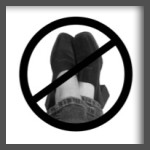False.
 Most people who cross their legs probably do so because they feel it is a comfortable way to sit. However, I ran across a few sources that claim people will cross their legs for a variety of reasons in a variety of social situations. For example, some people may cross their legs when they are nervous or anxious, others because it makes them feel distinguished or sophisticated, and for some crossing their legs may be a way to create a barrier and protect personal space when interacting with someone new. For me, I often cross my legs when I am sitting in long meetings due to pure boredom. It gives me a reason to move around a little bit and helps me stay awake. Sometimes I pretend the foot I have elevated in the air is a fishing rod and I am casting for rainbow trout in a secluded mountainous river in Colorado.
Most people who cross their legs probably do so because they feel it is a comfortable way to sit. However, I ran across a few sources that claim people will cross their legs for a variety of reasons in a variety of social situations. For example, some people may cross their legs when they are nervous or anxious, others because it makes them feel distinguished or sophisticated, and for some crossing their legs may be a way to create a barrier and protect personal space when interacting with someone new. For me, I often cross my legs when I am sitting in long meetings due to pure boredom. It gives me a reason to move around a little bit and helps me stay awake. Sometimes I pretend the foot I have elevated in the air is a fishing rod and I am casting for rainbow trout in a secluded mountainous river in Colorado.
Some believe that crossing your legs can increase the pressure in your lower legs or block blood flow and cause varicose veins. There is no evidence that crossing your legs causes varicose veins, or makes existing varicose veins worse. A varicose vein is a vein near the surface of the body that for a variety of reasons might begin to lose its elasticity, the walls (or sides) may begin to weaken, and blood may pool in these veins causing them to enlarge or balloon up. Roughly 20 to 25% of adults will develop varicose veins. Even though crossing the legs doesn’t cause varicose veins, some people report discomfort in the ankles, knees, hips, and even low back after they sit with their legs crossed. Lee and colleagues (2003) showed that height, family history, and obesity are likely reasons people develop varicose veins. Other reasons might be pregnancy, standing for long periods, and physical inactivity. If you enjoy sitting with your legs crossed you can do so without fear that you are causing varicose veins. Happy fishing!
Reference:
Lee A, Evans C, Allan P, Ruckley C, Fowkes F: Lifestyle factors and the risk of varicose veins: Edinburgh vein study. Journal of Clinical Epidemiology (2003), Vol 56, pps. 171-179.
